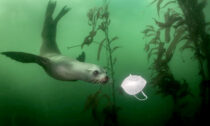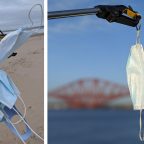
You’re out for your daily walk. You see a face mask on the ground. Few want to touch what has shielded someone’s potentially virus-laden breath. So there it lies until it blows away—and that elemental problem is rapidly changing the landscape around the world, from grocery store parking lots to beaches on uninhabited islands. Vaccines we mastered in record time to combat COVID-19. Litter in the time of the pandemic, it turns out, frustratingly defies solution.
A year ago, the idea that disposable face masks, gloves, and wipes could become global environmental pollutants was not a pressing concern. Personal protective equipment, PPE for short, was seen as essential for preventing the spread of COVID-19. No one imagined just how much of it would be needed, for so long. Then production exploded—and now the litter is inescapable.
In the time since, scientists have built a library of more than 40 studies that document the use and disposal of PPE and model what that looks like on a global scale. Numbers not known then tell the tale now.
Globally, 65 billion gloves are used every month. The tally for face masks is nearly twice that—129 billion a month. That translates into 3 million face masks used per minute.
A separate study reports that 3.4 billion face masks or face shields are discarded every day. Asia is projected to throw away 1.8 billion face masks daily, the highest quantity of any continent globally. China, with the world’s largest population (1.4 billion) discards nearly 702 million face masks daily.
All may be called disposable, because they’re cheap enough to be used once and then thrown away. But here’s the hitch: They don’t actually go away.
Disguised plastic
Face masks, gloves, and wipes are made from multiple plastic fibres, primarily polypropylene, that will remain in the environment for decades, possibly centuries, fragmenting into smaller and smaller microplastics and nanoplastics. A single face mask can release as many as 173,000 microfibres per day into the seas, according to a study in Environmental Advances.
“They’re not going anywhere,” says Nicholas Mallos, who oversees the Ocean Conservancy’s marine debris program.
Littered face masks and gloves are blown like tumbleweeds into rivers and streams, which carry them to the seas. Scientists have recorded their presence on South American beaches, river outlets in Jakarta Bay, in Bangladesh, on the coast of Kenya, and on the uninhabited Soko Islands in Hong Kong. Discarded PPE has clogged street drains from New York City to Nairobi, and has gummed up machinery in the municipal sewage system in Vancouver, British Columbia.
The stuff is affecting animals. The innovative common coot, a foot-tall, white-faced bird, has been observed in the Netherlands carrying face masks away to build nests—assuming its large, gangly feet don’t become entangled in the mask loops. That has happened, sometimes fatally, to swans, seagulls, peregrine falcons, and songbirds, according to a study in Animal Biology.
Face masks, gloves, and wipes are not recyclable in most municipal systems and should not be added to any household recycling bin. Masks can contain a mix of paper and polymers, including polypropylene and polyester, that can’t be separated into pure streams of single materials for recycling. They are also so small they get caught in recycling machinery, causing breakdowns. (PPE used in medical facilities is disposed of as hazardous medical waste.)
Joana Prata, an environmental health researcher at Portugal’s University of Porto, and lead author of a study on pandemic repercussions on plastics, noted that citizens need clear information on use and disposal of PPE. “This includes proper disposal as mixed waste in closed leak-proof bags,” she wrote.
A larger global problem gets worse
The problems created by PPE litter have arrived at a complicated time in the effort to curb plastic waste. The amount of plastic waste accumulating in the oceans is forecast to triple in the next 20 years, with no real solution on the horizon. If every corporate pledge to use more recycled plastics were kept, the shift would reduce that projected tripling by just 7 percent.
The pandemic has also seen increased production of disposable packaging, as consumers have bought more takeout food, and as bans of single-use plastics, including shopping bags, were suspended because of fears that reusables would spread the virus. Many recycling centres and household waste disposal facilities have been closed or restricted during the pandemic.
Assessing the spread
As face masks and gloves became increasingly visible, the Ocean Conservancy, a nonprofit that advocates for ocean protections, began last summer to assess the pervasiveness of PPE litter around the world. The organisation added PPE to its mobile app that allows volunteers to document trash items and upload them to the organisation’s website. In a global survey of volunteers who participated in beach cleanups in summer 2020, 107,219 individual items of PPE litter were documented, though the group’s leaders concluded that figure is likely a “vast underestimate.”
A better measure may come from the volunteers themselves; 94 percent reported seeing face masks, gloves, and other PPE litter in their communities on a regular basis, while half said they see PPE litter daily. Forty percent reported seeing PPE litter in streams, rivers, and oceans.
“The problem is huge; there’s no hiding that,” Mallos says. “But remember, this is on top of the existing global crisis of plastic waste. It’s a matter of public health, and also ocean health.”
The group has pressed for phasing out of redundant and unnecessary plastic packaging, and since the pandemic, for improvement in takeout food packaging, replacing it with other packaging materials such as cardboard that don’t have the same impact as plastic packaging when discarded.
What can be done?
Within days after the pandemic was declared last March, Justine Ammendolia, a marine researcher based in Toronto and a National Geographic Society grantee, noticed face masks and gloves in increasing numbers as she took her daily walks. She also noticed lack of structured monitoring of PPE by any governmental or other organisation as it spread throughout the city.
To identify hotspots, Ammendolia herself documented face masks, gloves, and wipes at six sites, including two grocery store parking lots, a hospital district, two residential areas, and a recreational trail. She logged 1,306 items over five weeks last summer. Not surprisingly, the grocery parking lots had the most, followed by the hospital district.
“It’s not the biggest amount of plastic in the world,” she says, “But, the thing is, we’re going to be changed after this event, as is our relationship with disposability. This raises attention to the amount of waste being produced.That is the starting point of the conversation.”












Social Profiles